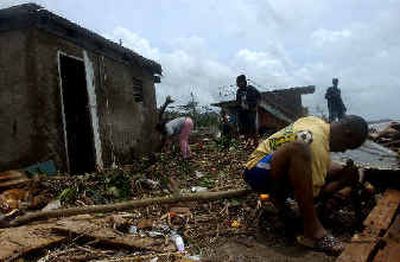Hurricane Ivan thrashes the Caymans

GEORGE TOWN, Cayman Islands – Hurricane Ivan battered the Cayman Islands with ferocious 150-mph winds Sunday, flooding homes, ripping off roofs and toppling trees three stories tall as its powerful eye thundered past. It then strengthened to Category 5 as it moved today on course for Cuba.
Ivan has killed at least 65 people across the Caribbean and was expected to strike western Cuba, where residents have dubbed the storm “Ivan the Terrible,” today. More than 1 million Cubans were evacuated from their homes.
Ivan’s near 160 mph winds made it a Category 5 hurricane – the strongest – capable of causing catastrophic damage.
The storm, initially predicted to brush the Florida Keys, now appeared to be on a track to hit the Florida Panhandle. Mexico issued a hurricane watch and tropical storm warning for the northeastern Yucatan Peninsula.
The hurricane, which grew to Category 5 on Saturday, lost some strength before its winds pummeled the wealthy Cayman Islands chain, a popular scuba-diving destination and banking center. It is the fourth Atlantic hurricane of the season.
“It’s as bad as it can possibly get,” Justin Uzzell, 35, said by telephone from his fifth-floor refuge in Grand Cayman. “It’s a horizontal blizzard. The air is just foam.”
Donnie Ebanks, deputy chairman of the British territory’s National Hurricane Committee, estimated that as many as half of Grand Cayman’s 15,000 homes were damaged.
At 8 p.m. PDT, Ivan’s eye was about 175 miles southeast of the western tip of Cuba. Hurricane-force winds extended 90 miles and tropical storm-force winds out to 200 miles. Ivan was projected to pass near or over Cuba’s western end by this afternoon or evening. The U.S. National Hurricane Center in Miami said the storm surge could reach 25 feet with dangerous, battering waves.
The Cayman Islands were better prepared for the punishment than Grenada and Jamaica, which were slammed by Ivan in the past week – though Jamaica was spared a direct hit Saturday. The Caymans have strict building codes and none of the shantytowns and tin shacks common elsewhere in the Caribbean.
The Hurricane Center said ham radio operators on Grand Cayman reported that people were standing on the roofs of homes because of storm surges up to 8 feet above normal tide levels.
While Ivan made a nearly direct hit on Grand Cayman, the eye of the storm did not make landfall, passing instead over water just south of the island, said Rafael Mojica, a Hurricane Center meteorologist.
Still, emergency officials said residents from all parts of the island were reporting blown-off roofs and flooded homes as Ivan’s shrieking winds and driving rain approached Grand Cayman, the largest of three islands that comprise the British territory of 45,000 people.
The airport runway was flooded and trees were wrenched from their roots, including a giant Cayman mahogany next to the government headquarters in downtown George Town. Radio Cayman went off the air temporarily.
Though there were no immediate reports of injuries in the Caymans, the death toll elsewhere rose as hospital officials in Jamaica reported four more deaths, for a total of 15. Police in Grenada reported five more deaths for a total of 39.
Ivan also killed five people in Venezuela, one in Tobago, one in Barbados, and four children in the Dominican Republic.
A tropical storm watch was posted Sunday morning for the portion of the 120-mile Florida Keys stretching from the Seven Mile Bridge west through Key West and into the Dry Tortugas. A mandatory evacuation was ordered for tourists and the island chain’s 79,000 residents.
In Cuba, the threatened area includes densely populated Havana, where traffic was light Sunday morning as most took shelter. About 1.3 million people across the island of 11.2 million were evacuated, with most seeking refuge with relatives.
“This country is prepared to face this hurricane,” President Fidel Castro said Saturday night. The storm is the most powerful to threaten this island nation since Castro came to power in 1959.
In western Cuba, dozens of families in the coastal town of La Coloma bundled up clothes, medicine, furniture and television sets before boarding buses to shelters.
“I feel sad leaving my house on its own,” said Ricardo Hernandez, a 44-year-old fisherman on his way to the inland capital of Pinar del Rio province. “But I have to protect myself and save the lives of my family.”
Iberia Cruz, 50, who lost her home in a hurricane two years ago, moved her valuables to a nearby building.
“We’ve lived through others, and that is why we are afraid,” Cruz said. “The ocean could pierce the town.”
The last Category 5 storm to make landfall in the Caribbean was Hurricane David, which devastated the Dominican Republic in 1979, Mojica said.
Only three Category 5 storms are known to have hit the United States. The last was Hurricane Andrew, which hit South Florida in 1992, killing 43 people and causing more than $30 billion in damage.
Ivan was projected to dump up to 1 foot of rain in the Caymans, possibly causing flash floods and mud slides, the Hurricane Center said. Its 150 mph winds were just below the 155 mph level qualifying it as a Category 5 storm.
In Mexico, hundreds of people abandoned fishing settlements on the island of Holbox as Ivan approached. The resort city of Cancun opened shelters and closed off all beaches as winds picked up on the coast.
Meanwhile, Hurricane Javier, with sustained winds of 75 mph, was building up strength Sunday far off the Pacific coast, meaning Mexico could face two hurricanes in one week.
Jamaica, an island of 2.6 million people, was saved from a direct hit when Ivan unexpectedly wobbled and lurched west Saturday, but it still suffered heavy damage as 25-foot waves crashed onto beachfronts, destroying homes and toppling trees.